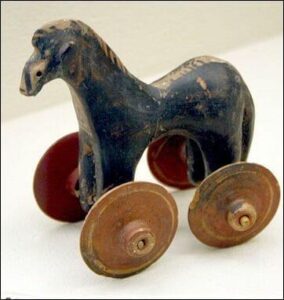THE SAGA OF SCALE MODELS
If you believe in the statement, ‘It all begins with something small’, scale models prove it right. These miniatures have deep roots in history, developed from toys, to then depict huge architectural monuments, scale models have impacted the modeling sphere. These miniatures are a symbol of man’s creativity and intelligence in being a visualizer. The tiny tods resemble the massive structures not only with their look and finesse but also in the way it functions. It all began with imagination and this imagination is only infinite!
Beginning of the ERA
Back in 3000 BC, miniature models were discovered through excavation, they were in the form of some civilization structures, which showed that clay modeling was used to demonstrate the routes of the habitat.

https://www.architektonix.com/model-making/history-of-modeling/
We later find that the first scale model was in the form of a toy, a horse with wheels, this episode again belongs to 3600 BC. This toy structure is still preserved in the Archaeological Museum of Heraklion. Miniature models then started using materials like wood and metal to make smaller illustrations of larger bodies. These models usually were connected with day-to-day dwellings like miniature models of animals, vehicles, humans, and houses.

https://www.motoroids.com/features/subrato-sen-the-origins-and-history-of-scale-models/
Father of Scale Model
In 1868, Frenchman Charles Rossignol started making toy scale models and is considered to be the Father of modern-day scale models. A major development in the scale model industry took place with the creation of miniatures of cars, trucks, mechanical machines, bikes, etc. In the 19th century, manufacturers began producing kits for people to build models of ships, trains, and other vehicles. The hobby developed and evolved throughout the years, with different tools and materials available to aid the design process. Scale models are representations of real-life objects, usually at a reduced buck scale. During World War II, scale model building became popular as a hobby among soldiers, and after the war, it continued to grow in popularity. Welding came into development and hence metal models would now be attached by welding. In the post-war era, the use of plastic for model building increased, making models more affordable and accessible to a wider audience. The use of plastic for scale models gave rise to a commercial aspect to scale modeling. The use of plastic for the creation of scale models made it easy to build perfect scale models with great accuracy and detailing. The scale models became quite cheaper due to the use of plastic as well as they were durable for commercial usage.
Evolution of Plastic
The scale model revolution began with stiff paper models in the late 1800s, followed by injection-molded plastic models of cars during World War II. The introduction of Airfix and Revell plastic scale models to the market in the 1950s sparked a huge interest in scale model building. Architects have also found uses for scale model building when creating architectural models out of various materials such as paper or foam board, plaster, or wood. These are used to create three-dimensional representations of buildings for planning purposes. These plastic scale models were modernized with the use of paints and other detailing methods to achieve a realistic look. Overall, Scale Model Building has evolved tremendously over the years from simple paper models to complex replicas made from multiple materials. This gave a route for scale models to the architecture and infrastructural world. Engineers and architects began using scale models to depict the massive infrastructures which would take years to build, but one could see and analyze the concept through scale models. Scale models got well-known as concept-selling miniatures. And since then till today scale models are used on large scales to create structures of buildings, to depict infra development.

Digital Modeling
It is a craft that has been practiced since many ancient civilizations. By creating miniature buildings, architects and builders were able to represent architectural elements in a physical form, which led to the development of some of the earliest architectural models. This type of modeling is used as an effective tool for building techniques. Today, Scale Model Building comes in many forms with varied construction materials and techniques. For example, architects use dimensional drawings or computer-aided design (CAD) programs to create scaled replicas of historical monuments or modern buildings. Furthermore, model makers often use different materials such as wood, plastic, or metal for their miniature creations. Additionally, some scale models are created using 3D printing technology that allows for more precise detailing in shapes and forms thus creating accuracy in detailed models.
Conclusion
From hand-made models to digitalization, scale models have come a long way. Today, scale model building is accepted as a reputed profession around the world, there are also numerous clubs and organizations dedicated to this profession, as well as competitions and exhibitions where model builders can showcase their work. What began small, today has a massive place in the field of engineering. Scale models form the first step of imagination, and as mentioned above imagination has no limits!